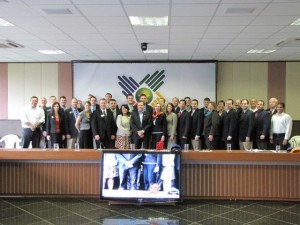
Class with New Governor of Mato Grosso
It’s Friday in Mato Grosso and the group is anxious to learn more about the agriculture in this state where crop production reins king. We started our day at Palacio Paiaguas with vice Governor (incoming Governor in one month) Silval. They are very proud that Mato Grosso is the leading food producing state in Brazil while using only 7.8% of it’s’ area for crop production. 36% of the land area accounts for all livestock, crop production and cities leaving 64% of untouched natural habitat.
The current Governor Blair Maggi administration has an obvious ambition to improve the quality of life for Mato Grosso citizens; rural and urban. Their major goals are to improve logistics infrastructure; roads funded by the government (state, federal and toll), partially funded railroads to be completed in 2-4 years, waterway improvement. The principal route for exports is to travel 1,000km on roads to the nearest ports. In only eight years they have created 4,000km of new paved roads in Mato Grosso. There is also a desire to create more value-added opportunities in addition to livestock and poultry operations.
Next we talked with Colonel Maia. He told us that the pressure from European Union clients for environmental responsibility weighs heavily on their decision making. Environmental groups like Greenpeace and other NGO’s create an unfavorable image of Amazon deforestation. He encourages us to be ambassadors to others and explain Brazil’s Mato Grosso regulation of reserved land in the Amazon Biome (80%) and Cerrado Biome (65%) that will never be cleared for production.
Many environmental groups use misrepresented analogies when talking about the amount of deforestation that takes place. For example, they will say that 1,000 soccer fields were cleared in one year. This is not the large soccer field size you most likely automatically think of. These are 2.4 acre size (1 hector) soccer fields that your children play on the local neighborhoods. They don’t go for snap shots of reality, but shock factors for the large sector of population not involved in agriculture.
Our next speaker was the Mato Grosso Environmental Secretary Daldegan. His environmental state agency is known as SEMA Mato Grosso. It is responsible for licensing, permitting and registering agricultural land in Mato Grosso. When he began his department only had two employees and a budget of $2.5 million real. Today there are 840 employees and $90 million real (~$60 million dollars). The most important license to farming operations in the LAU or Rural Property License.
Brazil current land reserve requirements have increased significantly in some areas from the original requirements. These original founders from the 1970’s and 1980’s are determined pioneers in this area and feel that they should be grandfathered into the current regulations and registration because they deforested in compliance. Secretary Daldegan has instituted a type of immunity plan where producers will not be heavily fined, but will be given time to reforest or purchase undeveloped land to meet requirements.
The SEMA website shows us real time images of the land in Mato Grosso right down to the owners and all related land statics for the property. This website is fully accessible to anyone on the internet as is therefore fully transparent to anyone seeking this information. Their commitment to land reserves and conservation was very apparent to the group.
Our next stop was the FAMATO building to meet with Amaggi Enterprises, a multi-national (and proud of it) company involved in the production, industry and transport of soy. Gustavo and Edmar explained to the group how the Amaggi Group is a member of the Roundtable of Responsible Soy, formed in Europe in 2004. The critical juncture of this organization was when the world wildlife fund inserted a ‘zero deforestation plank’ in its platform. Many agriculture organizations exited at this time, but Amaggi remained. The essence of Amaggi business plan is non-GMO soy production.
By becoming Amaggi certified (sort of their ISO-9000) producers become eligible for financing, input acquisition and marketing (no premiums). Several of their requirements include:
- Registration with SEMA and becoming compliant
- Social programs for child development and health support
- Compliance with Amaggi Certification
Following lunch we boarded the bus to begin our journey north from Cuiaba to Lucas do Rio Verde. During our 5 hour bus ride we were able to ask questions to Ricardo. Our trip began with a landscape of degraded pasture on a Maggi Government paved road. We were amongst long lines of tandem trailer trucks each hauling 759 bushels of soybeans to sea ports (a four day trip) or to the railroad terminal in Alto Araguaia. After some time spent stopped for construction and maneuvering amongst the trucks we have a better understanding their transportation challenges.


Leave a Reply
You must be logged in to post a comment.